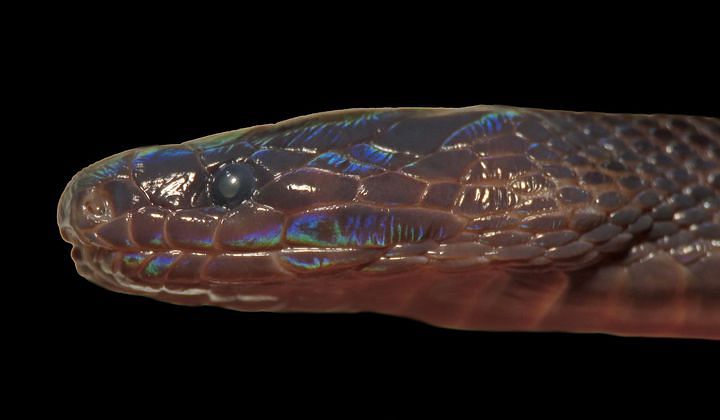The iridescent, subterraneous snake belongs to one of the least-studied types of reptiles in the world.
The Smithsonian Institution Museum of Natural History announced the discovery earlier this week in concordance with a scientific paper published in the journal Copei describing it. An international team of researchers found a single specimen of the snake on a road within a karst forest in Bac Me District, Ha Giang Province in 2019.
Achalinus zugorum belongs to a genus of snakes found in Asia known as Achalinus, which are commonly known as "odd scaled snakes" because their relatively small scales do not overlap like most snakes, but instead have skin in between. They are also unique in lacking bright-light photoreceptors in their eyes, which suggests they burrow under leaves or soil. These differences can be explained by the fact that the new species branched off of the snake evolutionary tree earlier than most of its peers.

Illustration by Sydney Sieh-Takata via the American Society of Ichthyologists and Herpetologists.
The discovery was during a larger survey to learn more about the biodiversity of reptiles and amphibians in northern Vietnam funded by the Smithsonian Institute's Global Genome Initiative. “When you see these species descriptions come out, they seem like a very small piece of the puzzle. But when everyone’s working on these smaller projects, it facilitates big, macro-evolutionary studies about the evolution of life," explained article author Aryeh Miller.
Scientists had previously discovered a different species of odd scaled snake in nearby Quang Ninh Province and note that continued research is necessary to understand and discover new species of reptiles and amphibians and the ecosystems they are a part of. “The goal is to eventually find ways for the environment and people to coexist,” said Miller.
The Achalinus zugorum specimen was brought to the Smithsonian so its DNA could be sequenced and added to the biorepository. It will then be returned to Vietnam to be cataloged. Truong Nguyen, vice director of the Institute for Ecology and Biological Resources at the Vietnam Academy of Science and Technology, co-authored the scientific paper with Miller and noted that he hopes this discovery will inspire Vietnamese to consider the biodiversity and importance of conservation of karst forests that are threatened by quarrying, rapid deforestation and the over-harvesting of species.
Achalinus zugorum was named in honor of retired Smithsonian curator George Zug and his wife, Patricia Zug. Nguyen says: “Scientists from the Smithsonian and the Institute of Ecology and Biological Resources at the Vietnam Academy of Science and Technology, have known each other for several years via George Zug. We built a partnership around biodiversity research and conservation in Vietnam, so we are happy to name a new species after professor Zug and his wife.”
[Top photo via Smithsonian Institute Magazine]















